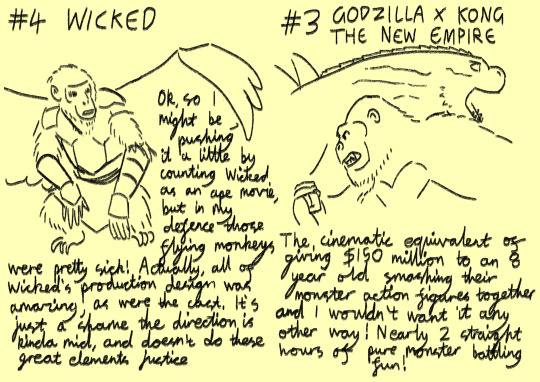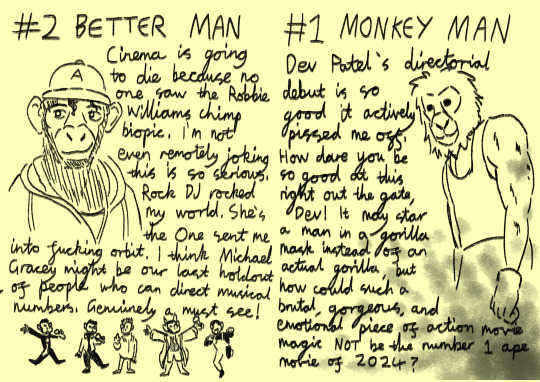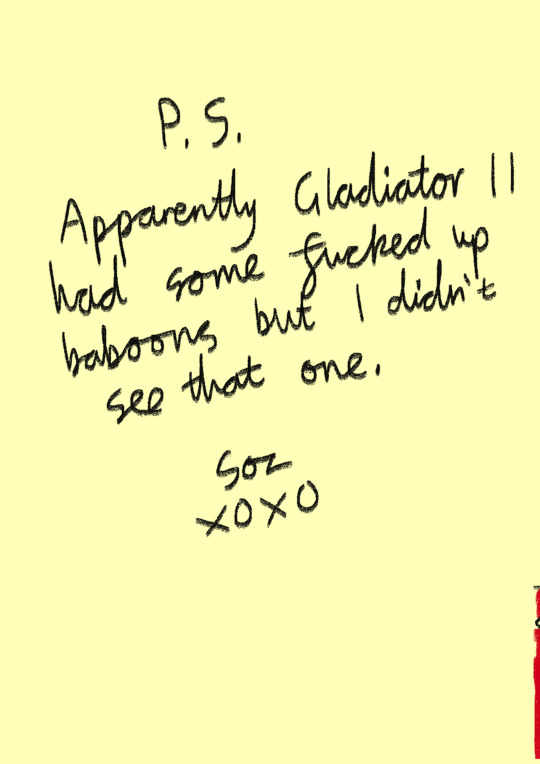#ape king
Explore tagged Tumblr posts
Text

Monster mayhem
#digtial artist#digtial illustration#digtial drawing#digtial art#orginal character#my art#Tales of Dragon’s Hier#sorcress#Punk girl#Kimberly (TODH)#Sophie#Skinwalker king#Ape king#juri#Lilith#lycanthrope#redraw#Darkstalkers
3 notes
·
View notes
Text

🦧 “Now, here’s your part of the deal, cuz. Lay the secret on me of man’s red fire.” 🌴🍌🐵🐒
#King Louie#character study#Disney fanart#The Jungle Book#orangutan#ape king#ancient ruins#temple ruins#ruin city#jungle#I Wanna Be Like You#Louis Prima#Milt Kahl#Frank Thomas#John Lounsbery#Walt Disney#Jim Cummings
5 notes
·
View notes
Text

今月描いた絵⑤ | AP
444 notes
·
View notes
Text

Snowy
#godzilla#gojira#king kong#kongzilla#kojira#monsterverse#kaiju#i'm late for Valentine's Day#but anyways#kong eepy#titanus gojira has been staring at him only god know how much#he thinks ape pretty#old man yaoi
454 notes
·
View notes
Text

BANANA SLAMMA! 🍌
#donkey kong#donkey kong country#doweesig art#donkey kong bananza#nintendo#diddy kong#dixie kong#cranky kong#king k. rool#king k rool#pauline#super mario#my art#pauline mario#doodles#Crystal coconut#primates#apes#chimps#monkeys#crocodile#kremling
201 notes
·
View notes
Text
EVERYBODY IS LEGALLY REQUIRED TO WISH NAKAHARA CHUUYA A VERY HAPPY BIRTHDAY TODAY!!!!!!!!!!!!!!!!!!!!
#my glorious king i wish i could draw him but alas i have ap’s to study for FUCK MY STUPID BAKA LIFE#shit is NOT making sense in the manga rn but he’s alive and safe and that’s literally all i could ask for#anyway#HAPPY BIRTHDAY CHUUYA 😍😍😍#bsd
341 notes
·
View notes
Text
started from the bottom



now we're here



#netflix#kong king of the apes#godzilla planet of the monsters#the cloverfield paradox#gamera rebirth#godzilla minus one#ultraman rising#kaiju
531 notes
·
View notes
Text



watched all the movies recently
#pota#planet of the apes#planet of the apes fanart#pota caesar#caesar pota#ape#apes#art#apes together strong#ape king caesar#koba the betrayer#i liked the old movies but the second one was such a trip#zira and cornelius were so cute though#reboot is still probably the best in my opinion#caesar’s story is simple and beautifully written#he’s an amazing leader
600 notes
·
View notes
Text
recent sketch dump GO (more under cut)

kongs that i drew while art blocked, quite frankly my hand was tired as hell and I should not have been drawing lol


wof stuff 🫶

aliens requested by my friends

susie deltarune (I miss her 💔)

sylva and lightning!!! i hate these freaks!!! fucking goblins!!!

fanmothra stuff, I have brainworms
#some of these are shittier than others#kong#king kong#godzilla#godzilla x kong: the new empire#godzilla x kong#kongzilla#wof#wings of fire#glory wof#peril wof#queen scarlet#clay wof#tsunami wof#sunny wof#starflight#predator#gigan#cloverfield#susie deltarune#deltarune#kingdom of the planet of the apes#kotpota#planet of the apes#pota#sylva#lightning#mothra#kalgoji#sketch
283 notes
·
View notes
Text


Tales of dragon Hier: The Ape King
Name: The Ape King
Age: 78 years old
Gender: Małe
Sexuality: Asexual
personailty: Barbaric, ruthless, tyrannical and loved solving things with violence.
Born in place: Hollow Earth
Species: Apemen
Voice actor: Kevin Durand - Proximus Caesar from Kingdom of the Planet of the Apes
#my art#digtial artist#digtial illustration#digtial drawing#digtial art#oc ref sheet#oc reference#orginal character#Tales of Dragon’s Hier#Ape#The Ape King#Ape King
2 notes
·
View notes
Text

Behind the scenes during the making of King Kong (1933).
113 notes
·
View notes
Text

不知火舞ちゃん🥰 | AP
153 notes
·
View notes
Text
Y Mab Darogan 1

(Stained glass window depicting Cadwaladr and his flag in Llandaff Cathedral, Charles Powell, 1919)

(King Arthur (top left), St Tewdrig, and St Cadwaladr, stained glass window in Llandaff Cathedral. Situated in the North Aisle, Charles Powell, 1919)
'The awen predicts they will make haste;
We shall have treasures, possessions, and peace
And broader leadership and lively leaders;
And after war, dwellings in every area;
Men fierce in fight-clamour, furious warriors,
Swift in attack, slow to leave defence-
Fighters that scatter foreigners as far as Caer Wair'
- the opening first lines of Armes Prydain
Something a bit different today but I thought I'd yell about ‘Y Mab Darogan’ or The Prophesied Son, who was seen as a messianic figure in Welsh literature and was appellated to four* (!) different lads (including King Arthur). This will be a long one so please have a snack and a drink at hand. You're gonna need ‘em.
Now, Y Mab Darogan as a concept first crops up in the 10th Century poem ‘Armes Prydain’ (The Prophecy of Britain) from the Book of Taliesin. Andrew Breeze postulated that the poem was written in about ‘940 AD.’ Taliesin’s status as ‘a seer’ write Gwyneth Lewis and Rowan Williams in their introduction to The Book of Taliesin: Poems of Warfare and Praise in an Enchanted Britain means that ‘it is not at all surprising’ to find a collection of Prophetic poems alongside the others within Llyfr Taliesin. ‘Its themes,’ Lewis and Williams further write, ‘are recycled in several later poems looking forward to a reunification of the British - usually Under the leadership of Gwynedd - and the advent of a heroic deliverer.’
It's a call for all Celtic nations (Welsh, Scots, Irish, Cornish, Britons, Manx) to come to arms against the Anglo-Saxon invaders - as can be seen in the lines 'long-haired champions, masters of war/ Will come from Ireland to drive out the Saxons.', 'Both loyal men will come from Alt Clud, / A resplendent army to drive them from Britain' 'A powerful host will come from Llydaw (Brittany),' 'Let the Cymry rise up, a war-like company' and 'On all sides shame will be the Saxons destiny' and, although it doesn't feature King Arthur proper it's writing kinda alludes to his death.
To zoom through some background, Hywel Dda (yes, he of Law fame) was seen as very much toeing the line to the Angles - who y'know were (and kinda still are) Wales’ traditional enemies. Now, for ol’ Hywel, this had meant that when Edward the Elder ruled over Wessex had had to cleave to him to ensure that Wales didn't get battered within an inch of its life as had all other Celtic nations in Britain (so the Gaels, the Picts, etc, etc). However, once he was out of the picture and his son, Athelstan, had taken over, an alliance of the kingdoms of the Strathclyde*, Dublin, and Scotland had all risen against him. In a break from tradition - y'know, the whole Men of the North business where it was acknowledged and expected that the Welsh would aid their compatriots - Hywel vehemently denied the three kingdoms’ aid leading to their defeat at the Battle of Brunanburh in 937.
Obviously, this pissed A LOT of Welsh lads off.
I mean, yeah, it'd piss me off too. if I expected a battle only to find out we weren't getting one cuz some lawmaker lad had to keep his neighbours happy I'd be LIVID. So this poem was written! No word if Hywel read it, but I imagine his Goodreads review would've been a firm one star.
In it, it refers to ‘Thus they'll avenge Garmon's* friends with force/ Four hundred and forty years on' and, according to the Annales Cambriae (my absolute beloved) in 537AD there was: ‘The Strife of Camlann, in which Arthur and Medraut perished; and there was plague in Britain and Ireland.’ which means ‘404 years’ after that is 941. Therefore, the poem is very much looking forward to the annihilation of the Saxons in 941 which kinda happened because Edmund had to accept a humiliating treaty at Leicester in 941, giving the north-east of England to the Viking leader Olaf Guthfrithson.
Also, the poem invokes two famous leaders - Conan of Brittany, and Cadwaladr ap Cadwallon of Gwynedd - in the line: 'Cynan and Cadwaladr, warlords in the armies' Cadwaladr is seen as hot shit - basically on par with Arthur as a ‘Great Deliver’ figure for the Welsh - and, somehow, the Welsh Dragon has become known as Cadwaladr's flag. Cadwaladr is also important because Henry VII (yeah, HIM) claimed descent from him. The hoped-for leader is seen as returning from exile - just as Cadwaladr is said to have done and Henry VII would later do once he'd hot-footed it to France to get aid - or arriving from over the sea - as Owain Lawgoch would later unsuccessfully attempt to do in the 1300’s - and ‘on their return they … overthrow corrupt or alien rulers within Wales, and rally other Welsh kingdoms to resistance and ultimate victory over the English.’
Now, as I previously alluded to, King Arthur is pretty much absent from the early corpus which makes up the ‘Mab Darogan’ legend. The ‘fierce resentment’ of the Armes Prydain makes no mention of him, and, therefore, we must look elsewhere.
We find it in the Gwyddelian composed Historia Brittonum. He's specifically indicated as fighting the Saxons (ons of the main tenets of the job, I think we'll all agree) and doing… okay. T. Charles Edwards states, ‘The victories of a Gwrthefyr, or an Arthur, might be glorious but they had no future,’ and, I think, it is this utter glory and utter ineffectualness that highlights the two main tenets of what makes you mab darogan, well, y mab darogan.
Arthur ‘echoes the achievements of Gwrthefyr’ in his chapter and so brings with it another key building block of y mab darogan. He is an echo of what has coms before and what will - hopefully, futilely - come again. A warrior will rise and lead through Britons - the Welsh, the natives of the land - to a brief taste of freedom before slipping away in a haze.
Furthermore, T. Charles Edwards states, ‘Perhaps the main concern of the author of Historia Brittonum is to encourage the Britons to come to terms with defeat of loss and territory.’ Arthur, like Macsen Wledig before him, is a rallying point for the Welsh. A flashpoint. Arthur is the ‘British Dux’ or warlord, the rebellious leader at will bring the Saxons to heel.
The legend of him being Y Mab Darogan amongst the Welsh is thought to have taken widespread hold after this. He's seen as a rallying cry for various rebellions and poets made use of his stature to advance various other disaffected Welshmen's causes. The Anglo-Norman text ‘The Description of England’ states that ‘openly they [the Welsh] go about saying,... / that in the end, they will have it all; / by means of Arthur, they will have it back... / They will call it Britain again’ So this would firmly put him in the bracket of The Welsh Lord and Saviour, kiss fuckin kiss. Furthermore, Daniel Helbert in his essay, ‘The Prophetic Hope in Twelfth Century Britain,’ states ‘at the close of the twelfth-century, the idea that King Arthur would return from the grave and lead his people to victory was not a new one,’ for the power and popularity of this legend both within Britain and on the continent as a whole (i.e. in Brittany where Arthur - and, later, Owain Lawgoch - is also seen as a somewhat Messianic figure in his own right) had an ‘allure’ to it. This suggests that, to me, the ‘Breton/Briton Hope’ was always a powerful sticking point in people's heads. Arthur had already left an indelible mark on culture, be it Welsh, Anglo-Norman, or otherwise, and people would use it in whatever ways suited them.
But I also must caution against believing this outright. *sigh* Arthur is Welsh*, yes. The building blocks of his myth are Welsh. I do not dispute that. However, O.J. Padel says that no contemporary Welsh source of a prophecy concerning Arthur's return to Britain has been found, and Charles T. Edwards further states: ‘Although the use of a Welsh battle-poem has been suspected, perhaps rightly no such source is likely … And if there was such a poem celebrating Arthur's battles, its date remains entirely uncertain.’ While there exists plenty of poetry on Arthur's ‘descendants’ as it were, Owain Lawgoch and Owain Glyndŵr, there is nothing particularly concrete for Artie and, furthermore, we must both rely on non-Welsh texts AND Henry VII's propaganda during the Wars of the Roses when he was challenging the Plantagenets for the English throne.
(Personally, Arthur just likes to be a tricksy bastard and I wish he'd CEASE AND DESIST. Bro, I went to ur fuckin Grotto in Corwen* when I was a kid. You OWE me.)
Conversely, Arthur has been used to legitimise the English’s rule over the native Britons. Edward I, after his conquest of Wales, used ‘Round Tables’ to celebrate and justify his conquest of Wales - one of many Big Kicks in the Teeth for us, ngl, other than letting the Prince of Wales be a baby because he only babbled*, and having the true last Princess of Wales, Gwenllian, be shut up in a monastery when she was a baby - and the consequent ‘reunification’ of Arthurian Britain. The Galfridian texts also were even used to justify Edward's claim over the Scottish throne - after the House of Dunkeld came to an untimely end with Margaret, the Maid of Norway's, death at sea when she was only 7 - as Arthur conquered Scotland. Geoffrey of Monmouth, I'm hitting your ghost over the head with a boot. One with iron toe caps. And smeared in dung. Arthur's use as a colonial tool by both the Normans’ and the Plantagenet dynasty cannot be overstated. To do so is a great disservice that doesn't do anybody - least of all the Celtic countries who had their great mythological king beaten into this oppressive tool to try and bring them to heel - any favours.
Aled Llion Jones writes in Darogan: Prophecy, Lament, and Absent Heroes in Medieval Literature that the imagined victory of y mab darogan represents a ‘return to a united, unified legendary state of organicism’ which was once conjured in a long-lost son called ‘Unbennaeth Prydain or ‘The Sovereignty of Britain. Furthermore, Brud and Brut (that's Prophecy and History for all you non-Welsh speakers out there) were near-homonyms in medieval Welsh and the Brut y Brenhinedd - ‘Chronicles of the King's,’ which are an adaptation of Geoffrey of Monmouth's Historia Regum Britanniae - was framed as being the story of how British lordship over Ynys Prydain had been gained, flourished, and lost to the Saxons. Prophecy, therefore, provided how it would ultimately be won back by those who would come after Arthur.
But, I mean, Wales would have to wait to find out who their next Mab Darogan would be. Next week: Owain Lawgoch's Hot Shit Tour of France: How he Became Y Mab Darogan, Fucked About in Guernsey and Got Assassinated When He Was Cutting His Hair.
Some notes!
*Garmon is St. Garmon the Gaulish Bishop who visited Britain in the first half of the fifth century
*You could make the case that Owain Gwynedd could be seen as Y Mab Darogan considering his various run-ins with the Normans. However, you could say that about The Lord Rhys also and, if we’re getting into the meat of it, neither of those two lads are even seen as having faulty alarm clocks. Or chillaxing beneath a mountain.
*Strathclyde wasn't incorporated into Scotland until the 11th Century when it was annexed into the Kingdom of Alba. It would still be known as Ystrad Clud at this time.)
*Technically, Brythonic which is the forerunner to the Britons but, like, the language of the texts he is primarily featured in is Old Welsh. I know he's seen as an English figure but that's wrapped up on years and years of colonialism.
*That baby was later known as King Edward II whose reign was less than impressive, but extremely gay. Nice to see him committing to the Remarkable cosplay ngl. (Idk if he ever did that. I just think it's fun to imagine he did. Bet he was Lance.)
*The Grotto was so fuckin fun. If I can dredge up a photo of the Red and White Dragon fighting then I'll fuckin slap it up because ooooh, baby, it was SO COOL. Also, they had an animatronic Arthur asleep under a mountain. ANYWAY.
*Myrddin/Merlin was also associated with prophecy in the early Welsh texts particularly those about the mab darogan.
Background Reading and Sources:
Land of My Father's by Gwynfor Evans
The History of Wales by J. Graham Jones
Wales: England's Colony? by Martin Johnes (A Banger.)
The Book of Taliesin by Gwyneth Lewis and Rowan Williams
The Arthur of the Welsh by Rachel Bromwich (T. Charles Edwards is included in it. Strongly recommend it.)
The Earliest Welsh Poems by Joseph Clancy
Arthur in Medieval Welsh Literature by O. J Padel
The Welsh Triads by Rachel Bromwich
Lastly a quick aside: this is my theory but it is entirely possible that Arthur disinterring Bendigeidfran's head in Branch 2 of the Mabinogi could be seen as him taking up the 'heroic deliverer' role from an earlier Celtic hero. Certainly, while his head remained buried at Gwynfryn (White Hill, speculated to be Tower Hill in London) 'no oppression would ever come from across the sea to this island while that head was in its hiding place.' Bendigeidfran, like Arthur, was seen as the High King of Britain, and there is certainly an echo of Arthur about him. Arthur, in a fit of hubris, disclosed the head of Bendigeidfran from its resting place because 'it did not seem right to him that this Island should be defended by the strength of anyone, but his own.' And this 'was known as one of the Three Unfortunate disclosures,' so the Mabinogion says.
I'm not an academic but it is perhaps something to think about.
#arthuriana#welsh mythology#arthurian legend#the mabinogion#mabinogion#welsh myth#y mabinogi#arthurian mythology#arthurian legends#king arthur#taliesin#welsh history#welsh poetry#celtic mythology#y mab darogan#celtic myth#arthurian literature#arthurian#cymru#wales#cadwaladr ap cadwallon#welsh stuff
89 notes
·
View notes
Text





Finally finished my latest passion project - a zine aaaall about the different ape movies that came out in 2024! I think anyone who knows me will not be surprised I decided this topic was worth making a zine about lol
This was super different from the zines I usually make and was definitely a fun departure from the norm - hope u enjoy reading and perhaps get inspired to check out some of these films (especially if the film you're inspired to check out is better man. please watch better man. monkey man too obviously but better man needs the win right now)
And if you really enjoy reading, I'm gonna be dropping a link to download a printable version on itchio, if you fancy being able to print off and fold one of these bad boys at home. You can carry it around in your pocket for moral support or something!
And as always if you like what you see of my art and are interested in getting me to draw anything, you can check out my pinned post for info on commissions!
#zines#fanzines#planet of the apes#wicked#gxk the new empire#godzilla x kong#king kong#better man#robbie williams#monkey man#dev patel#art#digital art#artsying
55 notes
·
View notes
Text
𓃶 What Is The Wild Hunt?
The Wild Hunt is a common belief among many Northern European cultures. In short, the hunt is a cavalcade of ghosts, spirits, fairies, elves, and other spiritual beings that is said to sweep across our world every year. Depending on where your beliefs come from, when it happens will differ.
It is commonly believed that the leader of The Wild Hunt is a deity or figure of importance of some kind, such as Odin/Woden in Norse and Saxon traditions, or King Arthur in British lore. Other leaders of the hunt include but are not limited to:
𖤓 Arawn or Gwyn ap Nudd, commonly seen as the Welsh lords of Annwn
𖤓 Danish king Valdemar Atterdag
𖤓 The Norse dragon slayer Sigurd
𖤓 Biblical figures like Cain, Gabriel, Herod and the devil
𖤓 Gothic king Theodoric the Great
☾༺♰༻☽
𓃶 What Did People Do For The Wild Hunt?
The Wild Hunt was generally seen as a bad omen; one for destruction, famine, war, plague, or the death of the one who saw it. In many traditions, witnessing the hunt would result in the viewer being abducted to Otherworld or Underworld. Other times, those who were not protected would have their souls pulled from their bodies while they sleep, and they would join the menagerie of the dead.
To avoid this fate, people in Wales, for example, began the tradition of carving pumpkins as a way to avoid being taken by the fae. In Scandinavia, offerings like bread were put outside the home as an offering to the spirits joining Odin for the hunt.
☾༺♰༻☽
𓃶 When is The Wild Hunt?
Depending on where your beliefs stem from, there are various answers to this question.
In Britain, The Wild Hunt is associated with the autumn season, specifically around and on Samhain/The Autumn Equinox.
Scandinavian tradition tells us that they prepared for the hunt around December, specifically Yule/The Winter Equinox.
☾༺♰༻☽
𓃶 What Entities Are A Part of the Wild Hunt?
Many entities are associated with the Wild Hunt in different areas. These entities include but are not limited to:
𖤓 The Fae (The Sidhe, The Tlywyth Teg, etc)
𖤓 Spirits of the Dead
𖤓 Demons
𖤓 Valkyries
𖤓 The Spirits of Huntsmen or Nobles
𖤓 Horses (sometimes with an abnormal amount of legs)
𖤓 Wolves and dogs (sometimes spiritual in nature, i.e. the Cwn Annwn)
☾༺♰༻☽
#pagan witch#paganism#witchblr#witchcraft#the wild hunt#king arthur#avalon#gwyn ap nudd#arawn#welsh mythology#norse mythology#norse paganism#fairies#fae folk#fae#faerie#ghost#spirituality#celtic paganism
654 notes
·
View notes
Text

This is based on the part in the OG King Kong where he runs a fade with a Rex, only with more realistic designs, hence, why I made Kong’s design similar to Cas3yart’s anatomically correct King Kong.
#kong#King Kong#skull island#monsters#fanart#I threw in some moody lighting because I’m obsessed with how the PS2 tie-in game looks#llama kong is a cool idea in concept and I like kong looking more unique than any old ape#but trying for realism might sacrifice the dramatic ending in New York#King Kong’s definitely one of the easier monsters to make realistic#but the rule of cool still applies to him unfortunately
140 notes
·
View notes